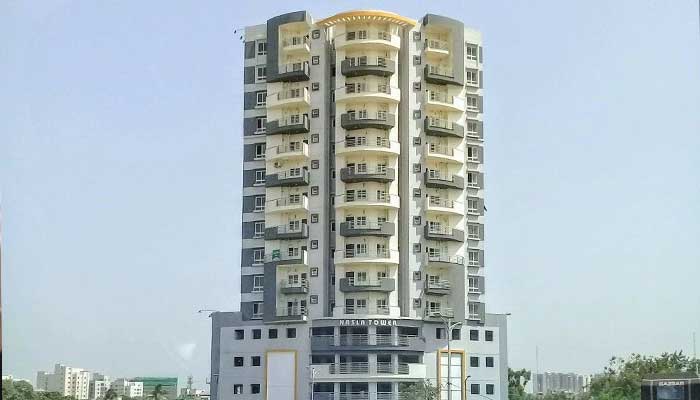‘Master plan dept accountable for Nasla Tower issue’
The plot’s original area was 780 square yards (sq yds), but commercial status was accorded to 1,044 sq yds.
Jamaat-e-Islami’s Saifuddin Advocate, who was the Nazim of union council 6 in 2007, when the residential plot on which the Nasla Tower was later constructed was given commercial status, says the job of his UC office was only that of a postman.
He explained that the UC office used to dispatch the applications of change in the status of land to the master plan department with or without objections. The Muttahida Qaumi Movement’s Mustafa Kamal was Karachi’s mayor at that time, so the department was under him.
The plot’s original area was 780 square yards (sq yds), but commercial status was accorded to 1,044 sq yds. The Supreme Court recently directed the city commissioner to remove all occupants from the building in the Sindhi Muslim Cooperative Housing Society (SMCHS), and then demolish it.
The court observed that after the examination of the record, there was no doubt that the building was constructed on encroached land, and among other things, also blocked the service road.
With just one objection by the non-profit Shehri, Saifuddin had issued a no-objection certificate for the conversion of land use on March 13, 2007, during his term as UC-6 Nazim.
On September 22, 2007, when Kamal was mayor, the master plan department under the City District Government Karachi formally approved the plot’s conversion from residential to commercial status, allowing shops, offices and flats to be constructed.
As a matter of routine, after publishing a notice for holding a hearing to listen to objections, the department used to share the cases of conversion of land status with the relevant UCs, explained Saifuddin.
“Whatever objections were raised during the public hearing, we used to forward them to the master plan department,” he said, adding that the final approval for commercial status was the department’s job.
He said they used to check if the plot was situated on a road that had already been declared commercial, so the application for change of land status did not seem to be problematic. “We also used to see if the [conversion of land] is creating a nuisance for the public. For example, if a cinema or a liquor store is being established,” he said, adding that if such nuisances were found, they used to report to the master plan department with their objections.
He stressed that even the recent SC order does not target commercialisation, but rather the illegal allotment of land. “If the SMCHS has illegally allotted the land, they should be asked about it.”
As for the JI’s stance on the issue, he said: “Whatever wrong or right happened has happened. Ultimately, the end-user or buyer is suffering now. If the plot can be regularised now, it should be.”
Plot No. A-193, on which the Nasla Tower stands today, originally measured 780 sq yds in 1950. The SMCHS allotted an additional 264 sq yds of the service road of Sharea Faisal to the then owner of the plot, increasing its size to 1,044 sq yds. Commercial status was accorded to the entire 1,044 sq yds.
Saifuddin said the conversion of land form mentions only the size of the plot, and not when and how it was increased. He said it was the master plan department’s job to go through the details of the plot before giving it commercial status.
He stressed that the department should also have checked the record before regularising the additional service road. Kamal could not be reached for comment despite repeated attempts.
-
 Queen Camilla Supports Charity's Work On Cancer With Latest Visit
Queen Camilla Supports Charity's Work On Cancer With Latest Visit -
 Dove Cameron Opens Up About Her Latest Gig Alongside Avan Jogia
Dove Cameron Opens Up About Her Latest Gig Alongside Avan Jogia -
 Petition Against Blake Lively PGA Letter Gains Traction After Texts With Taylor Swift Revealed
Petition Against Blake Lively PGA Letter Gains Traction After Texts With Taylor Swift Revealed -
 Netflix Revises Warner Bros. Deal To $83 Billion: All-cash Offer
Netflix Revises Warner Bros. Deal To $83 Billion: All-cash Offer -
 Prince Harry Mentions Ex-girlfriend Chelsy Davy In UK Court
Prince Harry Mentions Ex-girlfriend Chelsy Davy In UK Court -
 David, Victoria Beckham 'quietly' Consulting Advisers After Brooklyn Remarks: 'Weighing Every Move'
David, Victoria Beckham 'quietly' Consulting Advisers After Brooklyn Remarks: 'Weighing Every Move' -
 Meta's New AI Team Delivered First Key Models
Meta's New AI Team Delivered First Key Models -
 Prince Harry Defends Friends In London Court
Prince Harry Defends Friends In London Court -
 AI May Replace Researchers Before Engineers Or Sales
AI May Replace Researchers Before Engineers Or Sales -
 Christina Haack Goes On Romantic Getaway: See With Whom
Christina Haack Goes On Romantic Getaway: See With Whom -
 Consumers Spend More On AI And Utility Apps Than Mobile Games: Report
Consumers Spend More On AI And Utility Apps Than Mobile Games: Report -
 Aircraft Tragedy: Missing Tourist Helicopter Found Near Japan Volcano Crater
Aircraft Tragedy: Missing Tourist Helicopter Found Near Japan Volcano Crater -
 Taylor Swift Lands In Trouble After Blake Lively Texts Unsealed
Taylor Swift Lands In Trouble After Blake Lively Texts Unsealed -
 'Prince Harry Sees A Lot Of Himself In Brooklyn Beckham'
'Prince Harry Sees A Lot Of Himself In Brooklyn Beckham' -
 Kate Middleton’s Cancer Journey Strengthens Her Commitment To Helping Children
Kate Middleton’s Cancer Journey Strengthens Her Commitment To Helping Children -
 Gaten Matarazzo Compares 'Stranger Things' Ending To 'Lord Of The Rings'
Gaten Matarazzo Compares 'Stranger Things' Ending To 'Lord Of The Rings'




